It always seemed daft to me that the U.K. were involved in the Channel Tunnel Project (completed 1993), built a posh new London terminus at Waterloo International (opened 1994), acquired a fleet of French-designed high speed trains capable of speeds of 186 m.p.h. called TMST (Trans-Manche Super Train) and then ran these new trains for years on ancient third-rail electrified lines already congested with traffic. The complex new trains operated by Eurostar were introduced in 1993 and classified Class 373 in the UK. They could operate from 750v d.c. third-rail in England or from a number of overhead a.c. voltages. Various control systems were fitted including signalling systems TVM and KVB for use in the Channel Tunnel and in Continental Europe but only AWS was initially required to run on conventional lines in the U.K.
Class 373
The fleet of Class 373 was initially split into two types - 'Three Capitals' (to handle London-Paris and London-Brussels services) and 'North of London' (to deal with proposed feeder services within the U.K.). Trial running North of London was not encouraging - the existing electrified routes had difficulties supplying the new power-hungry trains and interference with signalling systems was problematic. As a stop-gap, conventional feeder trains, not available to ordinary passengers, were run to Waterloo to connect with services through the Channel Tunnel. I once managed to 'hitch' a ride from Wolverhampton to Birmingham on one of these restricted services from Manchester when the normal service was disrupted and I knew the Train Guard. This was a locomotive-hauled train with the coaches retro-fitted with central door locking. Load factors were disappointing on these feeder services, which were soon discontinued.
The enterprising GNER franchise leased some of the spare 'North of London' sets and, following the technical approval phase, managed to operate a service between King's Cross and, I think, York. At least some of the GNER sets were re-painted in dark blue, which suited them very well.
Raising speed from the Channel Tunnel to London
The Channel Tunnel Rail Link, also called 'High Speed 1' as the U.K's first high-speed line linking the Channel Tunnel to London, was built in two sections. The first section, opened in 2003, allowed high speed running at up to 186 m.p.h. between the Channel Tunnel and the Southfleet Junction (a little south of Gravesend) using the TVM signalling system. After an interchange section to Fawkham Junction (on the existing Swanley to Rochester lone) Eurostar trains then continued to Waterloo International station in London on third-rail d.c. electrified lines. In 2007 the second section of 'High Speed 1' was completed from Southfleet Junction to St. Pancras International, allowing maximum speeds of 140 m.p.h. The existing St. Pancras station required complete re-furbishment and a new station was built at the north end of the site to handle domestic trains and the extreme length of the International trains. Waterloo International became redundant after less than 14 years use. Although Waterloo International is slowly finding new uses, its design is not well-suited to handling domestic services. Incongruously, for a time a dramatisation of 'The Railway Children' was successfully staged in the International Platforms. In addition, the purpose-built North Pole International Depot which had serviced the Class 373 since their introduction had a rather short initial working life. It was not conveniently situated for providing trains to the new terminus at St. Pancras International so a new maintenance depot at Temple Mills replaced the original one at North Pole.
The Introduction of TPWS
Accidents such as Southall and Ladbroke Grove had focused attention on the limitations of the Automatic Warning System (AWS) used in Britain. It was not (nor intended to be) an Automatic Train Protection (ATP) system, since it could be over-ridden by the driver. Various schemes were afoot in Europe but, in an attempt to plot a course that was both affordable and achievable in a reasonable time-frame, the Joint Enquiry into Train Protection Schemes (available here concluded that a plan to supplement AWS with a Train Protection and Warning System (TPWS) should be implemented. All locomotives and multiple units, including Class 373, had to be fitted with TPWS in addition to AWS. There's an RSSB publication about these systems here.
Test Train on 6th October 2005
When I was writing about a trip on the Channel Tunnel Rail Link in early 2017 (Channel Tunnel Rail Link), I was reminded of an earlier trip on a Class 373 Test Train in 2005 which I have described below. The following is very much an historical account: since I became involved in the design and validation of some of the new equipment for Class 373 in 2005, so much has changed. I had one opportunity to travel on a special Class 373 Test Train from North Pole to King's Cross then to Grantham and return when I assisted with the tests being carried out. Arriving by road with our test equipment at North Pole, we found depot security quite tight but eventually lugged our gear onto the waiting train. Leaving North Pole International Depot we had to take an intriguing route across North London to King's Cross before we could start the proper test run to Grantham. We were using a recording multi-channel oscilloscope to collect data about the response of various sensors at different speeds.
North Pole International Depot to King's Cross
The Depot had four Reception Sidings (actually bi-directional) diverging from the Down West London Line and one Departure line (also bi-directional) which passed under the West London Line and trailed into the Up West London Line at North Pole Junction. Whilst these connections were convenient for getting to and from Waterloo, our train needed to head in the opposite direction to get to the East Coast Main Line. Having driven the train out of the Depot and south of North Pole Junction, the driver had to change ends before continuing. Whilst we made our way to King's Cross, I was involved in helping to set up and check the test equipment located just behind the 'active cab', so I couldn't pay much attention to our interesting route on the way out. We crossed over the Great Western Main Line before turning left at Mitre Bridge Junction, crossed over the West Coast Main Line at Willesden Junction High Level, crossed over the Midland Main Line at West Hampstead, turned right at Gospel Oak to join the North London Line at Camden Road. Here, we took the single North London Incline and joined the Down Slow of the East Coast Main Line, continuing to Finsbury Park where the driver had to change ends again. We set off and crossed to the Up Slow for the short journey to King's Cross. Now the equipment was set up and we were in the 'back cab', I was able to take a few pictures of the rain-swept railway.
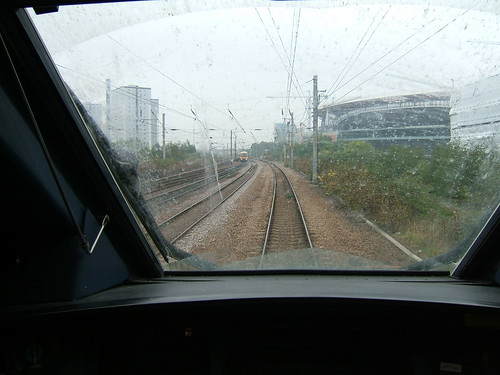
View from back cab of 373 passing Holloway Jns. on Up Slow en-route to King's Cross. Emirates Stadium on right.
At Holloway Junctions, we were switched to the Up Fast and then the Up Slow passed over us on a flyover, just north of Copenhagen Tunnels. This arrangement transposes the four running lines from Up Slow, Up Fast, Down Fast, Down Slow to Up Fast, Down Fast, Up Slow, Down Slow. This gets the stopping trains using the Slow Lines onto the west side of King's Cross, handy for Suburban platforms 9, 10 and 11. There were formerly three double-track bores forming the Copenhagen Tunnels but the East Bore is now disused. South of Copenhagen Tunnels, all four running lines become reversible and we were switched to the adjacent line which forms the Down Fast further north but is designated 'Number 1 Fast' here. I spotted the North London Incline we'd used earlier to access the East Coast Main Line before we were plunged into the 528 yard Gasworks Tunnels which were also formerly three double-track bores before the East Bore was abandoned.
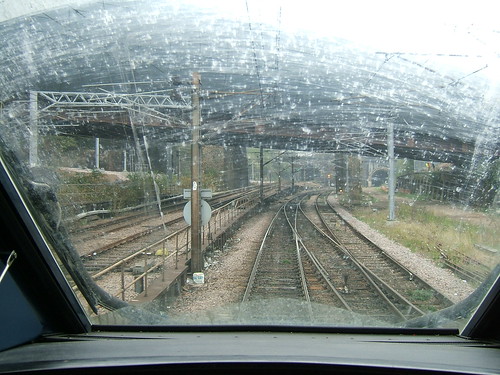
View from back cab of 373 on No. 1 Fast, Copenhagen Tunnels in background, North London Incline on left, CTRL viaduct above: East Coast Main Line.
We stopped in platform 6 and, of course, the driver changed ends once again. Before we set off, I managed to take the picture below from the leading cab before concentrating on the testing we carried out as the train sped northwards to Grantham.
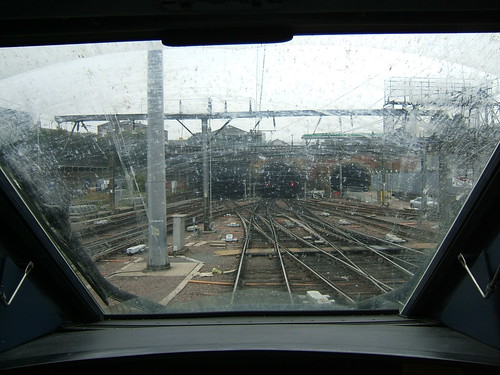
King's Cross on a rainy morning: View from now-leading cab prior to departure from platform 6 to Grantham, showing South Portals of Gasworks Tunnels.
King's Cross to Grantham
I was kept pretty busy monitoring the testing on the Down journey to Grantham. I'm not sure of the Line Speed Limit at the time, but we were batting along and passing signals frequently so there are no photographs recording the trip. We had a slight problem with the test gear at one point but, other than that, we collected plenty of useful data to be analysed later. It was still raining when we stopped at Grantham.
Grantham back to London
As soon as the driver had changed ends, we set off back to London, crossing to the Up Line on the crossover south of Grantham station. We were not carrying out active tests this time, as we were now at the rear of the train, so I was able to take a few pictures as we hurtled south.
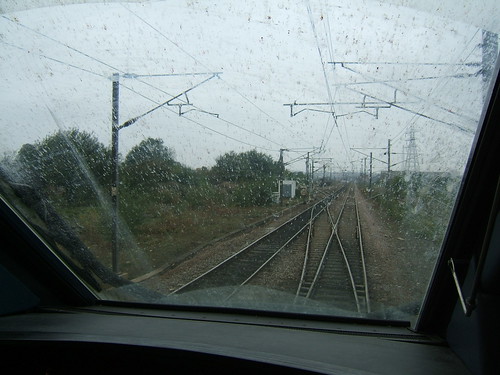
View from back cab of 373 passing Grantham South Junction as we cross to the Up Main for our journey back to London on the East Coast Main Line.
After the 880 yard Stoke Tunnel, the route became 4-track 'paired by direction' and we passed the site of "Mallard's" record breaking run.

Jan in the 'Back Cab' near Essendine on the return journey.
We reeled off another twenty miles at speed to reach Spital Junction, Peterborough.
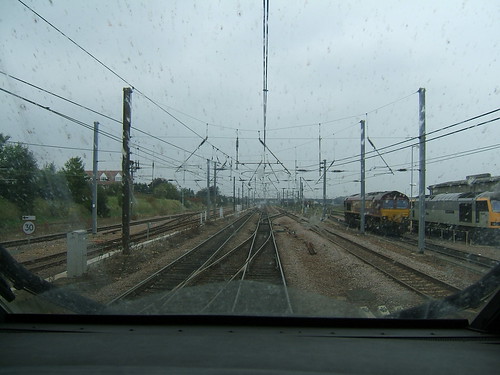
View from back cab of 373 at Spital Junction, Peterborough, with Peterborough North Depot on the right, on the way back to King's Cross: East Coast Main Line.
We took the Up Fast through Peterborough station and passed under the distinctive girder arch bridge which takes Thorpe Road over the railway.
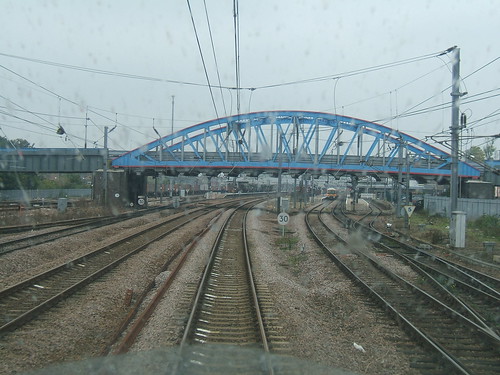
View from back cab of 373 south of Peterborough station on the way back to King's Cross: East Coast Main Line.
South of Hitchin, I was on slightly more familiar ground as, back in 1974, my firm had installed an Electrification Telephone system for British Rail between Hitchin and King's Cross. This is briefly mentioned in the post Electrification Telephone Systems for British Rail. Just north of Wood Green (the station is now called 'Alexandra Palace') we passed the flyover junction leading to the Hertford Loop.

View from back cab of 373 approaching Wood Green on Up Fast, passing an EMU on the Up Slow. The Enfield Viaduct carrying the Down Hertford is in the background and the Up Hertford is on the right: East Coast Main Line
We were routed onto the Up Slow at Finsbury Park, continuing on the Up Slow Flyover into the West Bore of Copenhagen Tunnels. At lowered speed, we took the crossover to the Down Slow and, emerging from Copenhagen Tunnel, diverged onto the North London Incline.

View from back cab of 373 on the North London Incline with the South Portals of Copenhagen Tunnels in the background as we returned to North Pole International Depot .
I noticed that construction work in connection with the various new connections to St. Pancras International was well advanced.
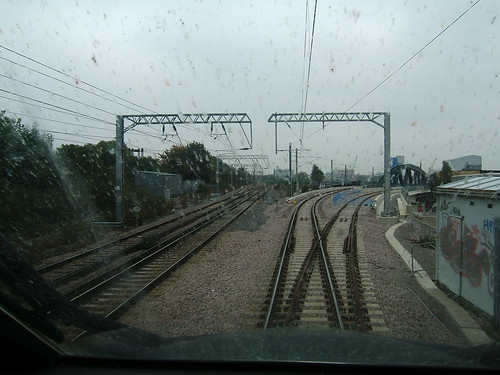
View from back cab of 373 on the North London Incline at Camden Road Incline Junction with new connection to Cedar Junction on the right as we returned to North Pole International Depot. The North London Line is on the left, with both third rail and overhead electrification. Camden Road East Junction is in the left background.
Our Test Train joined the North London Line at Camden Road Central Junction, and passed through the station where passengers were waiting for an expected Eastbound train at modest speed. After passing Camden Road signal box (since abolished) we diverged onto the branch to Gospel Oak.
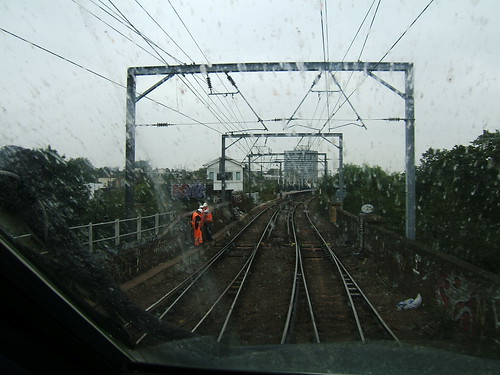
View from back cab of 373 passing Camden Road onto the Gospel Oak Branch as we returned to North Pole International Depot. This section of the North London Line has both third rail and overhead electrification.
We passed through Gospel Oak and continued fairly slowly to Kensal Green High Level Line Junction where we were routed onto the middle one of the three diverging routes.
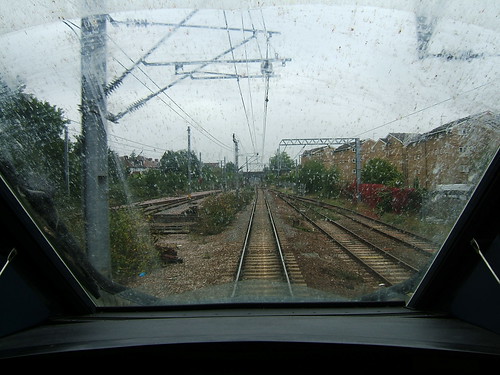
View from back cab of 373 passing Kensal Green High Level Line Junction on Down Line as we returned to North Pole International Depot.
Our route took us through Willesden Junction High Level station and the bridges over the West Coast Main Line. At Willesden High Level Junction signal box (since abolished) we took the sharply-curved Down High Level Line to Mitre Bridge Junction where we joined the Up West London Line, coming to a stand south of North Pole Junction.
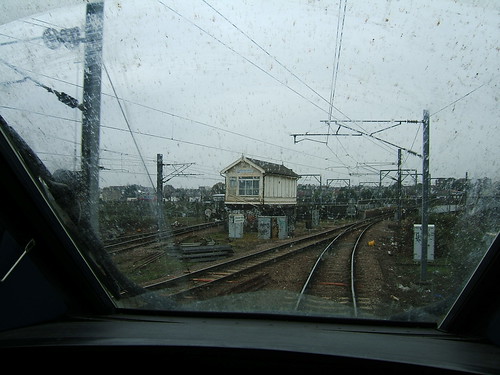
View from back cab of 373 passing Willesden High Level Junction and taking the sharply-curved Down High Level Line to Mitre Bridge Junction as we returned to North Pole International Depot.
After the driver changed ends for the final time, we made our way into the Depot, using the reversible Departure Line. We unloaded our test equipment and left the Class 373 after a productive and fascinating trip.

View of the Class 373 on arrival back at North Pole Depot.
References
Track diagrams showing North Pole International Depot and the route through Willesden Junction High Level are shown in publication:-
‘Railway Track Diagrams Book 5: Southern and TfL’ (TRACKmaps: 3rd edition) ISBN 978-0-9549866-4-3.
Track diagrams showing the route from North Pole International Depot to King's Cross and from King's Cross to Grantham are shown in publication:-
‘Railway Track Diagrams Book 2: Eastern’ (TRACKmaps: 3rd edition) ISBN 0-9549866-2-8.
The above issues show the route substantially as it was at the time of my journey: later issues will, of course, reflect subsequent changes.
Related sites
TRAIN PROTECTION IN THE UK. (The Railway Technical Web).
Related posts on this site
Channel Tunnel Rail Link
My Pictures
Where necessary, clicking on an image above will display an 'uncropped' view or, alternately, pictures from may be selected, viewed or downloaded, in various sizes, from the albums listed:-
Class 373: Test Train to Grantham.
[Extent of first section of 'High Speed 1' corrected: 12-Mar-2017]
